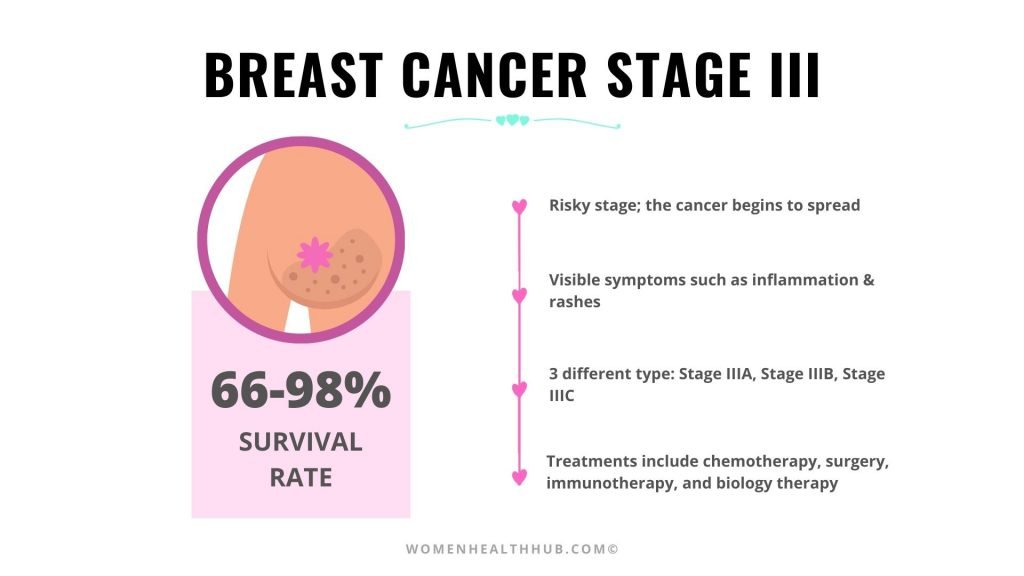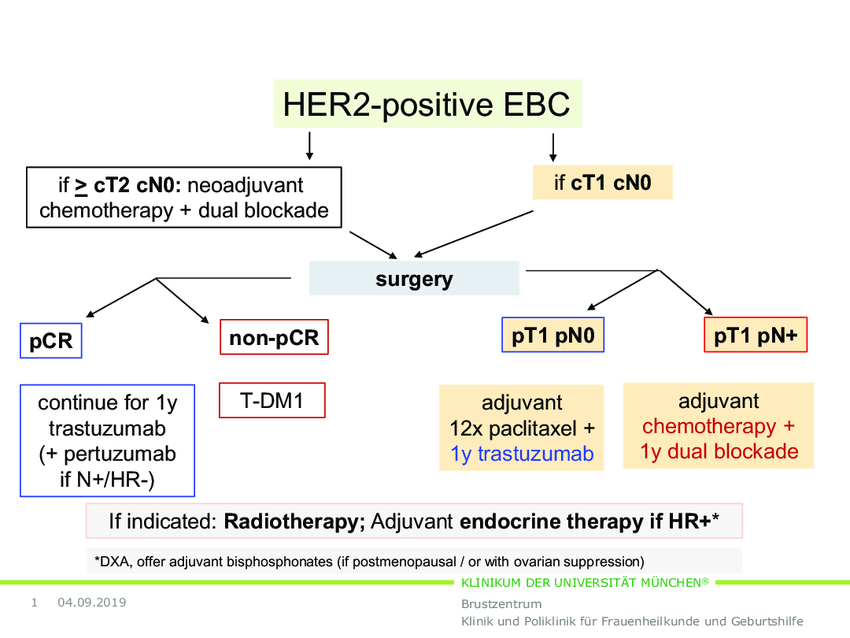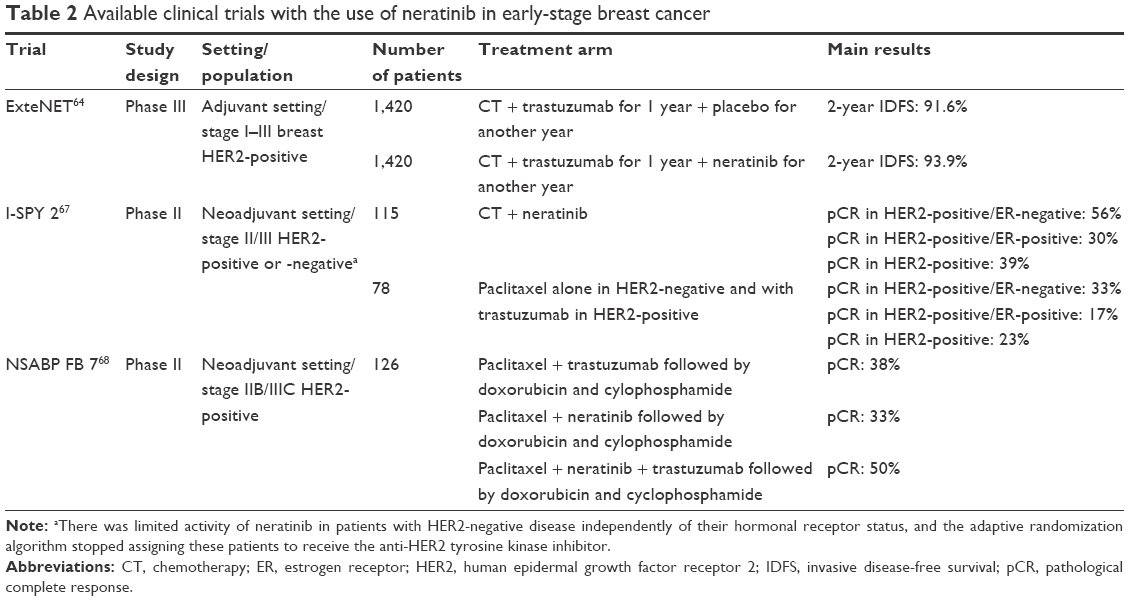Adjuvant Medical Therapies For Breast Cancer
Following surgical resection of the primary breast cancer, patients often receive adjuvant systemic therapy with the goal of eradicating clinically and radiographically occult micrometastatic disease that may develop into frank metastatic disease if left untreated. Selection of adjuvant systemic therapies is based on risk stratification of the patient. Two factors affect risk: disease burden and disease biology as determined by HR and HER2 status, and genomic assays. While patients with triple negative and HER2 positive cancers are generally considered to be high risk, there is considerable biologic diversity among those with HR positive, HER2 negative cancers. Based on trials demonstrating a small but statistically significant benefit for treatment of HR positive, HER2 negative, node-negative breast cancers with chemotherapy in addition to endocrine therapy, chemotherapy has been standard for healthy women in this group. Commercially available genomic assays including Oncotype DX and Mammaprint examine cancer-related genes in tumor-derived DNA to determine risk of recurrence and potential chemotherapy benefit. These commercially available tests have given clinicians more clarity on which patients should receive chemotherapy.
Is Chemotherapy Necessary Before Or After Breast Cancer Surgery Or At All
A recent study found that breast cancer has been highly over treated with chemotherapy and doctors can now confidently provide an alternative treatment known as Endocrine Therapy.
However, each patient is different with a unique set of circumstances. Chemotherapy is necessary in advanced stages, as well as early stages when specific characteristics are present, such as spreading to the lymph nodes or other body parts.
Probability Of Cancer Progression
How long the remission period can last is one of the most frequently asked questions by patients with stage 4 breast cancer. The answer to this question depends on a number of factors that come in.
First, tumors may have a different tendency to grow. Slowly growing tumors mean longer remission and longer life expectancy. Second, age is important. In young patients, cancer tends to be more aggressive and resistant to treatment. Third, the localization of metastases plays an important role. Metastasis to bone or lymphatic tissue is a more prognostic option for treatment than lung, liver, and especially brain damage.
Another very important factor is the tumors responsiveness to the therapy. In women with hormone-positive breast cancer, in which the tumor reacts well to hormone therapy, life expectancy can be 10-15 years, even taking into account the 4th stage of the disease. For comparison, the life expectancy of patients with metastatic triple-negative breast cancer is only one year.
You May Like: What Does Triple Negative Cancer Mean
What Is Stage 3 Breast Cancer
Also known as locally advanced breast cancer, the tumor in this stage of breast cancer is more than 2 inches in diameter across and the cancer is extensive in the underarm lymph nodes or has spread to other lymph nodes or tissues near the breast. Stage 3 breast cancer is a more advanced form of invasive breast cancer. At this stage, the cancer cells have usually not spread to more distant sites in the body, but they are present in several axillary lymph nodes. The tumor may also be quite large at this stage, possibly extending to the chest wall or the skin of the breast.
Stage 3 breast cancer is divided into three categories:
Stage 3A: One of the following is true:
- No tumor is found in the breast, but cancer is present in axillary lymph nodes that are attached to either other or other structures, or cancer may be found in the lymph nodes near the breast bone, or
- The tumor is 2 cm or smaller. Cancer has spread to axillary lymph nodes that are attached to each other or other structures, or cancer may have spread to lymph nodes near the breastbone, or
- The tumor is 2 cm to 4 cm in size. Cancer has spread to axillary lymph nodes that are attached to each other or to other structures, or cancer may have spread to lymph nodes near the breast bone, or
- The tumor is larger than 5 cm. Cancer has spread to axillary lymph nodes that may be attached to each other or to other structures, or cancer may have spread to lymph nodes near the breastbone.
Stage 3C:
Four Stages Of The Disease

There are 4 breast cancer stages. Stage 1 breast cancer is a single tumor up to 2 cm in size, which has no regional metastases. They are located in lymph nodes, in close proximity to the affected organ in the armpit fossa. Can you die from stage 1 breast cancer? Highly unlikely! For first stage breast cancer, survival rate averages 95% and reaches 100% in some developed European countries. Those numbers also answer the which cancer is the most curable question. The most important thing here is to contact a specialist after noticing the first signs of the disease.
Stage 2 breast cancer is a small tumor, up to 2 cm or slightly larger, but often with single metastasis in the armpit fossa. The more cancer that is in the body, the more actively its harmful cells travel through the body. If stage one and stage zero are considered to be almost safe and can be easily cured, then from stage two onwards, the treatment will differ in its intensity and the measures used. At this stage, the probability of positive treatment is 60-70%. The main priority is timeliness and the use of progressive treatment methods. In the case of remote metastases being present, the situation and treatment can slightly aggravate the effectiveness of progress.
Read Also: Did Anne Hathaway Have Breast Cancer
Breast Cancer Support And Resources
There are many resources and support groups for breast cancer survivors. Theres no obligation to stick with a group. You can try it out and move on whenever youre ready. You might be surprised to learn that you have a lot to offer others as well.
The American Cancer Society has a variety of support services and programs. You can call the 24/7 helpline at 800-227-2345, visit the website, or download the Life After Treatment Guide.
If you like having information at your fingertips, download the free Breast Cancer Healthline app. The app lets you connect with others who have a similar diagnosis and understand what youre going through.
A Lot To Learn About Alnd In Other Patients
Its important for doctors and patients to understand that these results can only be applied to women whose breast cancer and treatment regimen match those of the participants in the trial, the papers authors cautioned.
The results should not be used to direct the care of women with palpable axillary lymph nodes, women who had breast tumors larger than 5 cm in diameter, women with three or more positive sentinel lymph nodes, women who received chemotherapy or hormone therapy before surgery, and women who underwent mastectomy instead of breast-conserving surgery with radiation, they wrote.
We still have a lot to learn about ALND in other settings, commented Dr. Giuliano.
One trial, currently underway in Europe, is examining whether ALND can be skipped in some women who have a mastectomy for early-stage breast cancer, but results are not expected for years.
But for now, according to Edward Livingston, M.D., and Hsiao Ching Li, M.D., of the University of Texas Southwestern Medical Center, authors of an accompanying editorial, The ACOSOG Z0011 trial has shattered a century of belief that all cancer containing axillary lymph nodes must be removed in women with breast cancer.
Related Resources
Don’t Miss: How To Donate To Breast Cancer Charity
Outlook By Hr And Her2 Status
Outlook also varies based on tumor characteristics, such as subtype.
For example, here are the 5-year relative survival rates for different combinations of HR and HER2 status:
- 92% for HR-positive, HER2-negative cancer
- 89% for HR-positive, HER2-positive cancer
- 83% for HR-negative, HER2-positive cancer
- 77% for HR-negative, HER2-negative cancer
What Are The Symptoms Of Breast Cancer Recurrence
You may experience different signs of breast cancer recurrence depending on where the cancer forms.
Local breast cancer recurrence may cause:
- Breast lump or bumps on or under the chest.
- Nipple changes, such as flattening or nipple discharge.
- Swollen skin or skin that pulls near the lumpectomy site.
- Thickening on or near the surgical scar.
- Unusually firm breast tissue.
- Biopsy of the site of suspected recurrence.
Recommended Reading: Is Breast Cancer Curable In The 3 Stage
Treatment Of Breast Cancer Stages I
The stage of your breast cancer is an important factor in making decisions about your treatment.
Most women with breast cancer in stages I, II, or III are treated with surgery, often followed by radiation therapy. Many women also get some kind of drug therapy. In general, the more the breast cancer has spread, the more treatment you will likely need. But your treatment options are affected by your personal preferences and other information about your breast cancer, such as:
- If the cancer cells contain hormone receptors. That is, if the cancer is estrogen receptor -positive or progesterone receptor -positive.
- If the cancer cells have large amounts of the HER2 protein
- How fast the cancer is growing
- Your overall health
- If you have gone through menopause or not
Talk with your doctor about how these factors can affect your treatment options.
Staging And Management Of The Axilla
It is often assumed that preoperative imaging is useful in selecting patients undergoing BCT who require axillary dissection. However, the clinical question has shifted from the identification of any nodal metastases to identification of patients with 3 or more nodal metastases who are not candidates for sentinel node biopsy alone, and current imaging modalities do not reliably make this distinction. Pilewskie at al examined the utility of preoperative imaging in predicting the need for additional axillary surgery in 425 patients with clinical T1-2 N0 tumors and 1 or 2 positive sentinel nodes. Among patients with abnormal axillary nodes identified by mammogram, axillary ultrasound, or MRI, 71% did not require ALND using Z0011 criteria. Even among patients with a needle biopsy demonstrating nodal metastases, only 45% required ALND. Thus, preoperative axillary imaging in clinically node-negative patients should be reserved for those undergoing mastectomy where the finding of any nodal disease is an indication for ALND or preoperative chemotherapy to downstage the axilla.
Recommended Reading: Does Getting Hit In The Breast Cause Cancer
If Chemo ‘killed’ Everything
Then that would be a cure – it isn’t! THe different types are different. ER/PR/Her2 status is different for each of us as is Stage/grade/etc.
Very simplistically as it was explained to me for me – chemo neo-adjuvant to try to get it to shrink and form margins so surgeon had a chance of getting it. Then surgery to remove all that surgeon could find. Then another chemo to attack any that was ‘floating’ around in the lymph system or anywhere. Then rads to re-hit the direct area effected ‘just in case’.
Only you can decide what you want to do.
Winyan – The Power Within
|
Rads kill stray cancer cells left from the scalpel. If your onco suggests it as part of your treatment, I hope you will go ahead with them. They aren’t easy, but, you can do it. Hugs, Noel |
What Are The Side Effects Of Chemo Versus Endocrine Therapy How Does Each Impact A Womans Health

Side effects of Chemotherapy include hair loss, nausea, damage to the heart and nerves, and an increased risk of both infection and rare leukemia later in life.
Less severe, Endocrine Therapy increases menopausal-type symptoms such as hot flashes. Occasionally it also increases joint pain, muscle pain, and weight gain. One of the Endocrine Therapy drug options Tamoxifen rarely may increase the chances of cancer in the uterus. Most patients tolerate it very well.
Read Also: Is Breast Cancer Curable In The 3 Stage
What Does It Mean To Have Stage 2 Breast Cancer
Stage 2 means the breast cancer is growing, but it is still contained in the breast or growth has only extended to the nearby lymph nodes.
This stage is divided into groups: Stage 2A and Stage 2B. The difference is determined by the size of the tumor and whether the breast cancer has spread to the lymph nodes.
For Stage 2 breast cancer, chemotherapy is usually done first, followed by surgery and radiation therapy.
Inflammatory Breast Cancer Treatment
Inflammatory breast cancer is an uncommon and aggressive type of breast cancer caused by cancer cells blocking lymph vessels in the skin.
All IBC cases are classified as at least stage 3 breast cancer. If the cancer is metastatic , its considered stage 4.
Treatments for IBC depend on what stage the cancer is in.
Don’t Miss: Baking Soda And Honey Cancer Cure
What Are The Chances Of Breast Cancer Recurrence After Treatment For Stage 2 Breast Cancer
In women who have breast-conserving treatment, the chance of recurrence is about 3-15% in 10 years, depending on tumor characteristics and margins. Distant recurrence in those who had mastectomy is most influenced by axillary lymph node involvement. When axillary lymph nodes are not cancerous, the recurrence rate is 6% in 5 years. When axillary lymph nodes are cancerous, the recurrence rate is 23% in 5 years with mastectomy but no radiation.
When Is Radiation Usually Used To Treat Stage 2 Breast Cancer
According to the American Cancer Society, radiation therapy may be used after a breast-conserving surgery, or lumpectomy, to mitigate the risk of cancer cells recurring in the same breast or nearby lymph nodes. After a mastectomy, an oncologist may determine that radiation is necessary if the tumor was larger than 5 cm, if there was lymph node involvement, or if cancer was found outside of surgical margins.
Don’t Miss: How To Cure Breast Cancer With Baking Soda
How Can I Prevent Breast Cancer Recurrence
Healthcare providers dont know why some people experience breast cancer recurrence. A recurrence isnt your fault. You didnt do anything wrong to cause it or fail to do something more to prevent it.
Certain medications may reduce the risk of breast cancer recurrence in people who have early stage breast cancer. For estrogen-receptive breast cancer, hormonal therapies including tamoxifen or aromatase inhibitors block either the activity of estrogen or the bodys production of estrogen. Chemotherapy may also be recommended to reduce risk of breast cancer recurrence.
Early diagnosis may make it easier to treat a recurrence. Follow your healthcare providers recommendations for mammograms and other screenings. You should also perform regular breast self-exams. Get familiar with how your breasts look and feel so you can see your provider quickly if you notice changes. And remember that most breast changes occur for reasons other than cancer.
Purpose Of This Summary
This PDQ cancer information summary for health professionals provides comprehensive, peer-reviewed, evidence-based information about the treatment of adult breast cancer. It is intended as a resource to inform and assist clinicians in the care of their patients. It does not provide formal guidelines or recommendations for making health care decisions.
Also Check: Is Breast Cancer Curable
Breast Cancer: Types Of Treatment
Have questions about breast cancer? Ask here.
ON THIS PAGE: You will learn about the different types of treatments doctors use for people with breast cancer. Use the menu to see other pages.
This section explains the types of treatments that are the standard of care for early-stage and locally advanced breast cancer. Standard of care means the best treatments known. When making treatment plan decisions, you are strongly encouraged to consider clinical trials as an option. A clinical trial is a research study that tests a new approach to treatment. Doctors want to learn whether the new treatment is safe, effective, and possibly better than the standard treatment. Clinical trials can test a new drug and how often it should be given, a new combination of standard treatments, or new doses of standard drugs or other treatments. Some clinical trials also test giving less treatment than what is usually done as the standard of care. Clinical trials are an option to consider for treatment and care for all stages of cancer. Your doctor can help you consider all your treatment options. Learn more about clinical trials in the About Clinical Trials and Latest Research sections of this guide.
Dont Miss: How Old To Get Breast Cancer
Table 3 Definition Of Regional Lymph Nodes Clinical Ab

| Regional lymph nodes cannot be assessed . | |
| cN0 | No regional lymph node metastases . |
| cN1 | Metastases to movable ipsilateral Level I, II axillary lymph nodes. |
| cN1mid | Micrometastases . |
| cN2 | Metastases in ipsilateral Level I, II axillary lymph nodes that are clinically fixed or matted |
| or in ipsilateral internal mammary nodes in the absence of axillary lymph node metastases. | |
| cN2a | Metastases in ipsilateral Level I, II axillary lymph nodes fixed to one another or to other structures. |
| cN2b | Metastases only in ipsilateral internal mammary nodes in the absence of axillary lymph node metastases. |
| cN3 | Metastases in ipsilateral infraclavicular lymph node with or without Level l, II axillary lymph node involvement or in ipsilateral internal mammary lymph node with Level l, II axillary lymphnode metastases or metastases in ipsilateral supraclavicular lymph node with or withoutaxillary or internal mammary lymph node involvement. |
| cN3a | Metastases in ipsilateral infraclavicular lymph node. |
| cN3b | Metastases in ipsilateral internal mammary lymph node and axillary lymph node. |
| cN3c | Metastases in ipsilateral supraclavicular lymph node. |
Read Also: How To Cure Breast Cancer With Baking Soda